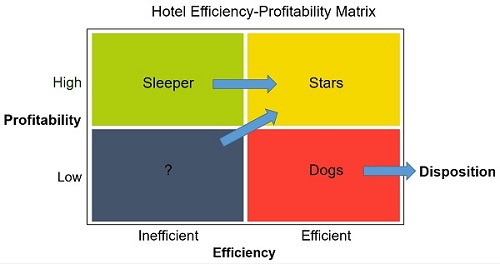Many argue that profitability is the only performance measure of relevance in the hospitality industry. The main argument against this is that environmental factors can affect the attainment of profitability. A profitable hotel may be being managed efficiently or it may be just enjoying favorable external conditions, whilst an unprofitable one may be being badly managed or simply experiencing unfavorable pressures from the environment.
In making decisions about hotels, both efficiency and profitability are relevant and one approach would be to use Data Envelopment Analysis (DEA) to determine efficiency and to separately determine profitability. The hotel could then be assessed on an efficiency/profitability matrix which has similarities in structure to the product portfolio matrix displayed above.
Hotels whose profitability and efficiency located them in the “star” quadrant are the flagship hotels and should provide examples of good operating practice and are probably also in a favorable environment. The “sleepers” are profitable but this is more to do with favorable environmental conditions than good management They are candidates for an efficiency drive leading to even greater profits.
The “question marks” have the potential for a greater efficiency and possibly greater profits. Attempts should be made to increase their efficiency and this may lead to greater profitability. The “dogs” are efficiently operated hotels but low on profitability due to an unfavorable environment. In the extreme case, it may be sensible to divest of these and deploy capital to other opportunities. This approach thus sees efficiency and profitability as two key performance measures, each of which can help with the management of the overall portfolio of hotels.

